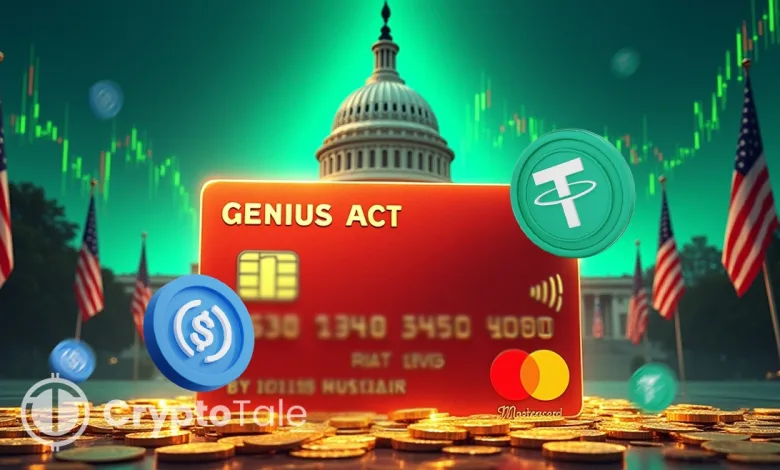Mastercard Moves on Stablecoins Post-GENIUS Act

- Mastercard builds stablecoin rails after GENIUS Act clears U.S. regulatory hurdles.
- Stablecoins shift to mainstream as Mastercard integrates them into global payments.
- GENIUS Act opens market for TradFi firms to launch compliant digital dollar systems.
With the GENIUS Act now signed into law, Mastercard has announced its strategic focus on stablecoin infrastructure development. This move positions the company as one of the first traditional finance (TradFi) leaders to align its operations with the new U.S. regulatory framework for digital assets. The GENIUS Act provides the legal clarity needed for large institutions to safely integrate stablecoins into their global networks. Mastercard’s infrastructure plans mark a significant development in the evolution of digital payments.
The GENIUS Act establishes the first federal framework governing the issuance and operation of stablecoins in the United States. It requires all payment stablecoins to be backed one-to-one by U.S. dollars or liquid assets. The law includes mandatory monthly reserve reporting and compliance obligations for both bank and non-bank issuers. These rules aim to create a stable environment for digital currency adoption by mainstream financial firms.
Mastercard’s Infrastructure Plans and Strategic Tools
Mastercard has launched initiatives, including the Mastercard Multi-Token Network and Mastercard Crypto Credential, to support its stablecoin operations. These tools offer compliance, interoperability, and user protection to ensure safe and scalable transactions across various platforms. The infrastructure is designed to connect banks, governments, and crypto firms under a unified payments framework. Mastercard aims to create a regulated environment that mirrors its existing credit card network structure.
These developments indicate Mastercard’s intention to serve as a trusted intermediary in the emerging stablecoin ecosystem. While stablecoins are often associated with decentralized finance, Mastercard’s model focuses on centralization and regulatory compliance. The firm plans to embed stablecoins within existing financial systems, ensuring dispute resolution and consistent user protection. This approach reflects Mastercard’s long-standing operational model in traditional payments.
Stablecoins’ Shift from Experiment to Financial Tool
The GENIUS Act accelerates stablecoins’ transition from speculative crypto assets to foundational components of the financial system. With legal certainty now established, financial institutions can issue and manage digital dollars with regulatory backing. This transformation supports broader use cases, including international payments, remittances, and business-to-business transactions. Stablecoins offer lower transaction costs and faster settlement compared to traditional payment systems.
Regions outside the U.S., such as the European Union, Singapore, and the UAE, have already implemented comprehensive digital asset regulations. These jurisdictions promote stability, cross-border collaboration, and market trust in digital currencies. The GENIUS Act aligns the U.S. with these global standards. It creates an environment where digital assets can be used as reliable financial instruments across multiple sectors.
Opportunities and Competition for Financial Institutions and Fintech
The act’s dual-licensing model allows both banks and qualified non-banks to issue regulated payment stablecoins. This regulatory structure is expected to open the market to traditional institutions and fintech startups. Companies can now innovate within a legally defined framework without fear of regulatory uncertainty. This clarity may challenge the dominance of existing unregulated stablecoin issuers.
Related: Mastercard Unlocks Stablecoin Access for Over 150M Locations
Mastercard’s early entry into the stablecoin infrastructure space gives it a competitive advantage over other TradFi firms. Its ability to implement regulated payment systems at scale could reshape how digital dollars are used in everyday commerce. The company’s existing relationships with banks and merchants further support stablecoin adoption. This integration can streamline digital payments for consumers and businesses worldwide.
Implications for the Future of Digital Payments
It is believed that the GENIUS Act will affect the international regulatory dialogue and enhance confidence in U.S.-issued stablecoins. It serves as an example of the model other nations would consider in order to develop parallel regulation of digital currencies. The infrastructure building of Mastercard is utilized as a framework design of TradFi scaling in the rise of stablecoins. It provides interoperability standards, conformity, and consumer safety.
With the rise of regulatory clarity, there is the possibility of other financial institutions adopting the steps that Mastercard is taking in terms of trying to integrate with digital currencies. Stablecoins are well on the way to becoming the building block of international payments and online business. This transformation is started by the GENIUS Act, which brings about secure and regulated innovation in financial services. The approach used by Mastercard is opening a new era of development of the digital economy.





